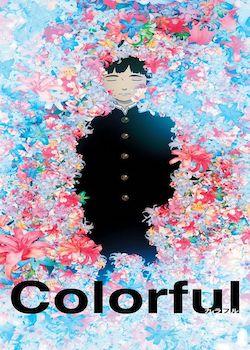Colorful

Directed by Keiichi Hara
2010, 127 minutes
Shown as part of the Japan Foundation UK’s annual touring film programme
Review by Mike Sullivan
Contains plot spoilers
This year’s Japan Foundation UK annual touring film programme offered an expansive introduction to Japanese cinema with the theme of ‘youth.’ A number of different movies were shown around the UK and many of the stories were of young men and women struggling to make sense of their identity in today’s world. The movie Colorful was screened at the ICA and included an introduction by the film’s director, Keiichi Hara, as well as a Q & A afterwards.
Keiichi Hara is most well known for directing TV programmes and movies such as Doraemon and Crayon Shin-chan. In 2007 he wrote and directed Summer Days with Coo, in 2010 he directed Colorful which was based on a story by Eto Mori and last year he completed his first live-action movie, Hajimari no Michi, which was a biographical movie about filmmaker Keisuke Kinoshita. Colorful won the award for Excellent Animation of the Year at the 34th Japan Academy Prizes, and at the 65th Mainichi Film Awards it won the Animation Film Award.
In direct contrast to its name the movie opens to a rather colourless scene, a dreary train station where shadowy figures either sit around or queue to get on a train. They are all the recently deceased. We view the inside of the station in first person, representing the view of someone who recently died and has no voice, their thoughts are shown as lines of text against a black background. This voiceless person seems to be aware that they died and have become resigned to this, although it appears they no longer remember their past life. Suddenly, a little boy pops up, who seems relatively normal in comparison to the other shadowy figures. He announces that the protagonist has won the lottery and will get another chance at life. This doesn’t seem to get the reaction that the little boy expected, our voiceless person seems unmoved by this and intent on joining the others departing the train station. However, with no small dose of exasperation and a bit of force the protagonist is led by the boy, Purapura, to a lift which leads back to life.
The protagonist is told that it is the soul of one who made a dreadful error but is being given the chance to return to life in order to realise its mistakes and atone for them. It is told that a boy has just died and that it will take its place. The protagonist opens its eyes to find a grieving family consisting of parents and an older brother – Makoto had attempted suicide three days before and had just died. In astonishment the doctors and family see him open his eyes.
Makoto is often visited by the little boy Purapura in order to give him guidance as he knows nothing about the life that he has taken over. However, as Purapura only gives him snippets of information Makoto behaves as he thinks he should, which surprises everyone around him. He is grateful to his family, he announces his intent to study hard at school and he directly tries to talk to those around him. All of these actions surprise people. One of his classmates becomes obsessed with how he is not the same person. As we gradually find out from Purapura, before committing suicide the Makoto from before had no friends at school, talked to no one and at home tended to remain in his room.
The new Makoto is told that he has six months before his new life will end and that he needs to remember what he did wrong in his previous life before the six months ends. During this time he learns about his family, about the other children at his school and about what had driven the previous Makoto to his death. This movie has a number of elements which touch upon a lot of different topics ranging from dysfunctional families, Hikikomori (young people who live reclusive lives), bullying at school, and of course the issue of suicide. Unfortunately, the pacing of the movie is a little uneven, and at 127 minutes a little too long, especially as some plot elements are quite simply too obvious. The movie is addressing topics that need to be talked about and should be applauded for this; however some important discussion points are omitted, such as how to address bullying, etc. Finally, there seems to be a suggestion from how Makoto has been represented that what he really needed, more than anything else, was to be kicked out of his rather selfish indulgent shell. This was how I felt but unfortunately this also means that he is at least partially being blamed for his own situation.
Apart from the issues mentioned above, as well as the film’s length, the movie is full of beautiful scenery and incorporates real life footage that has been blended with animation. This has been done really well and can make your eyes doubt whether you are watching an animated movie or a live-action movie.

